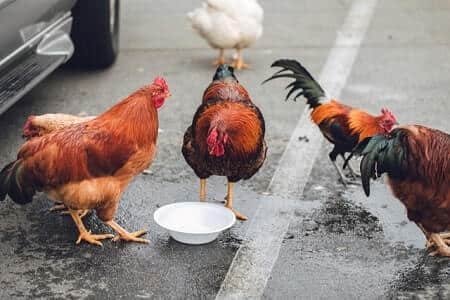When you buy chicks or chickens from a breeder you’ll almost certainly be told how old they are.
However, if you’re adopting or being given chickens by some other means and not told their age it can be hard to figure out how old a chicken is.
How to tell the age of a chicken? There are various physical and behavioral characteristics to look out for that can give you a good indication of how old a chicken is. Such as plumage, activity, egg-laying, crowing, and more.
Let’s start by looking at how chickens develop through the different stages of their lives:
Table of Contents
Baby Chicks to Pullets and Cockerels
You’ll know if you have baby chicks on your hands by their size and appearance.
If they just have some fluff and haven’t started to grow their first feathers yet, they are likely less than 8 days old.
Chickens then go through several mini molts as they develop a coat of juvenile feathers which should be finished when they’re about 20 weeks old.
Around this age is when you will also start to be able to tell the difference between males (cockerels) and females (pullets).
Male chickens tend to have pointer feathers and a thicker and longer plumage around their necks and saddle.
Their tail feathers (sickle feathers) will be longer too. Males also hold themselves more upright and have thicker legs.
Females are smaller, develop their combs slower, and are less boisterous.
Pullets and Cockerels to Mature Chickens

A pullet is a female chicken that has not yet started to lay. The age in which a chicken lays its first egg varies depending on the breed and some environmental and living conditions.
It’s not something you can take as an accurate gauge of their age. But it will give you a general idea.
With that said, most hens start laying between 20-24 weeks of age. If your hen is laying, you can be sure they are at least older than that.
If you bought or were given what is known as point-of-lay hens - which means they are ready to lay soon - you’ll notice the pelvic bones moving to make way for an egg.
They will typically lay smaller eggs at first too. This can be used as another indication of how old they are if you take in a chicken already laying.
If you have a rooster on your hands you’re going to hear that “cock-a-doodle-doo” when they are around 20 weeks old.
The combs and wattles will also be developing for both sexes, so these aren’t a very reliable physical trait to use for aging. If you have both males and females, the males will typically have larger combs if you’re interested in knowing the sex of your chickens.
Telling the Age of a Mature Chicken
When chickens, both males, and females are more than a year old it gets a little more difficult to tell how old they are.
If you have a hen, they should be in peak egg-laying age between 1-3 years of age. Check how many eggs per week your breed of chicken should be laying, and see if they’re operating on full production mode.
If all their environmental needs are met; 16 hours of light, good nutrition, stress-free conditions, etc and they’re laying less, it might be an indicator that they’re closer to 4-5 years old.
If you have a rooster, they are in their prime between the ages of 1-3 years old. They will be mating with several hens a day and bossing around the flock.
Roosters also slow down as they age, and who can blame them. They’ll mate less as they reach 4+ years in age.
Related - How long do roosters live?
Other physical signs that your chickens are reaching their senior years is that the color in their combs, wattles, and legs will fade.
Another thing to look out for is chicken’s first full molt as an adult. This usually happens around the 18-month mark.
It’ll typically happen in the late summer or fall so they can replace their feathers and have a nice warm coat in time for winter.
They’ll molt every year after though. So, if you’re not sure you witnessed their first molt, it can be hard to pinpoint their age or how many times they’ve molted.
Related - High protein foods to help molting chickens.
In Summary - Ways How to Tell the Age of a Chicken
As you can tell from following the timeline above, chickens grow up and mature very quickly. It’s easiest to get a good idea of their age when they are less than a year old and still developing physically.
There are still some good telltale signs to look for in the middle phase of their lives though. I can usually tell when a chicken is between 2-3 years old, or between 3-4 years old based on how active they are.
It’s difficult though, it’s not like they show signs of aging on their faces or turn grey as we do!
Keep in mind that most backyard chicken breeds live to between 6-8 years old.
With so many different breeds of chicken, there are always some exceptions to the rules, however.
Do your best to find out what breed you have and do some research into their individual characteristics and behaviors.
Image credits - Photo by Jason Leung on Unsplash




